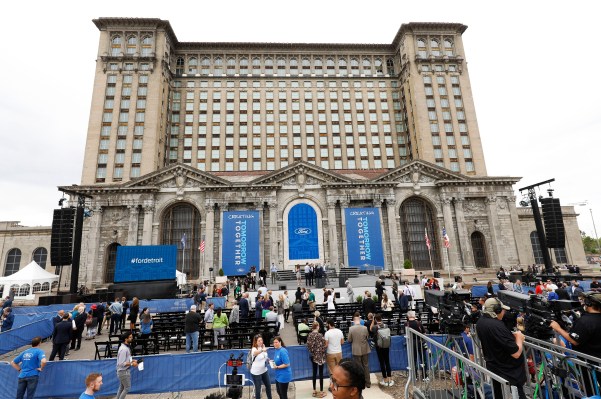Ford will spend the next four years transforming at least 1.2 million square feet of space in Corktown — Detroit’s oldest neighborhood — into a hub for its electric and autonomous vehicles businesses.
But the automaker’s ultimate aim goes beyond just building a new campus. The goal is to create a “mobility corridor,” — Ford’s version of its own Sand Hill Road in Silicon Valley — that ties hubs of research, testing and development in the academic hub of Ann Arbor to Ford’s Dearborn headquarters, and finally to Detroit.
Ford, which is celebrating its 115th anniversary this week, announced plans to house 2,500 Ford employees, most from its emerging mobility team, in its new Corktown campus by 2022. The new campus will have space to a accommodate 2,500 additional employees of partners and other businesses. The remaining 300,000 square feet will serve as a mix of community and retail space and residential housing.
The Corktown campus is where Ford will develop autonomous and electric vehicle businesses, as well as what CEO Jim Hackett describes as a new transportation operating system designed to make moving from Point A to Point B easier and accessible. The idea is for this transportation operating system to tie all forms of mobility together, including smart, connected vehicles, roads, parking and public transit.
You might remember that Ford announced in January plans to develop an open cloud-based platform for cities to use to manage all the disparate transportation modes (as well as data) happening at any given time. The idea is for the platform to help cities optimize their various modes of transit and provide a way for everything in the city, such as stop lights, signs and even bikes to speak to each other and share information.
The centerpiece of the new Corktown campus will be the long-abandoned Michigan Central Station, which Ford acquired.
Ford hasn’t forgotten about its main campus in Dearborn, Hackett emphasized during an event Tuesday in front of the Michigan Central Station.
“Our plans for Corktown won’t compete or won’t replace our campus in Dearborn,” Hackett said. “It’s actually one whole system.”
And while Hackett noted that Corktown and the acquisition of the Michigan Central Station is “great real estate” and a “great investment,” it’s not what drove Ford to make the investment.
“It helps us fast-track our transformation,” Hackett explained.
The company says it’s still working on the redesign of its Dearborn campus that started in 2016. This will continue in parallel with the Corktown campus development. This summer, the 150,000-square-foot Wagner Place development in West Dearborn is on track to open, as is a new driving dynamics lab located on Ford’s Product Development Campus.
The acquisition of Michigan Central Station follows the automaker’s purchase of the former Detroit Public Schools Book Depository, two acres of vacant land, the site of an old brass factory and the recent purchase of a refurbished former factory in Corktown.
